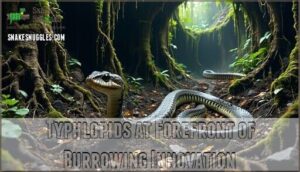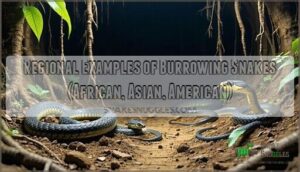This site is supported by our readers. We may earn a commission, at no cost to you, if you purchase through links.

They’re ecosystem engineers – their tunneling aerates soil, redistributes nutrients, and creates microhabitats for other organisms.
These fossorial species have evolved remarkable traits like reinforced skulls, reduced eyes, and powerful muscles to navigate subterranean environments.
Species like blind snakes and sand boas demonstrate how different lineages independently developed similar burrowing strategies.
Their underground networks influence water infiltration, root growth patterns, and invertebrate communities in ways scientists are still discovering.
The mechanics behind their incredible digging efficiency hold secrets that could revolutionize everything from construction techniques to robotic design.
Table Of Contents
- Key Takeaways
- What is a Burrowing Snake
- Evolution of Fossorial Behavior
- Dead-End Snakes – Where to From Here
- Regionalism Across Major Classes
- Burrowing Forces and Adaptive Traits
- Burrowing Mechanics and Their Impact
- Burrowing Snakes in Diverse Landscapes
- Frequently Asked Questions (FAQs)
- What snakes burrow in the ground?
- What is a burrowing snake?
- Can snakes burrow underground?
- Where do burrowing snakes live?
- How far underground do snakes hibernate?
- What snake lives in a hole in the ground?
- What types of snakes are most commonly found burrowing underground?
- How do burrowing snakes contribute to soil health and ecosystems?
- Can burrowing snakes be used as indicators of environmental health?
- What are the medicinal properties of some burrowing snake species?
- Conclusion
Key Takeaways
- You’ll discover ecosystem engineers – These underground specialists create complex tunnel networks that aerate soil, redistribute nutrients, and provide microhabitats for countless other species, making them essential architects of subterranean environments.
- You’re witnessing remarkable evolutionary adaptations – Burrowing snakes have developed reinforced skulls, reduced eyesight, powerful muscles, and specialized scales that enable them to navigate underground with incredible efficiency.
- You’ll find biomimetic inspiration everywhere – Their burrowing mechanics are revolutionizing robotics and construction, with engineers developing snake-inspired systems for search-and-rescue operations, medical procedures, and underground exploration.
- You’re looking at vulnerable conservation priorities – Many burrowing snake species face extinction due to habitat destruction and climate change, requiring urgent protection of entire underground ecosystems rather than just surface areas.
What is a Burrowing Snake
Delving into the domain of subterranean reptiles, you’ll discover that burrowing snakes represent nature’s most specialized underground architects.
These fossorial species constitute approximately 25% of all snake species, totaling over 1,500 remarkable creatures worldwide. Snake biology reveals fascinating adaptations: narrow heads for soil penetration, reduced eyesight for dark environments, and powerful muscular systems for excavation.
Burrowing snakes create diverse burrow types depending on their habitat needs – from shallow surface tunnels to deep vertical shafts. Their fossorial adaptations include pointed snouts, reinforced skulls, and specialized scales that reduce friction during movement.
Snake burrowing behavior varies dramatically across species, with some using head-first drilling motions while others employ concertina-like contractions.
These underground ecosystems support incredible diversity, from tiny blind snakes to larger species like sand boas. Each demonstrates unique subterranean life strategies, making them essential components of soil environments.
Understanding these adaptations reveals how evolution shapes creatures for life beneath our feet. The ability to utilize snake hole habitats is vital for their survival and ecological impact.
Evolution of Fossorial Behavior
Why do snakes abandon surface life for underground existence? The evolution of fossorial behavior represents one of nature’s most remarkable evolutionary adaptations. These fossorial specialists didn’t simply stumble into subterranean life – they were driven by intense evolutionary pressures including predation, competition, and resource scarcity.
Over millions of years, snake burrowing behavior became increasingly sophisticated as species developed specialized burrowing strategies. Fossorial adaptations transformed entire body plans. Snake morphology shifted dramatically, with heads becoming wedge-shaped, bodies elongating, and sensory systems adapting to darkness.
Evolution doesn’t ask permission—it simply reshapes life to survive underground darkness.
This evolutionary journey created today’s subterranean ecosystems, where snakes serve as ecosystem engineers. Consider the emotional impact of this transformation:
- Survival instinct: Escaping predators through underground refuge
- Adaptive resilience: Overcoming seemingly impossible environmental challenges
- Evolutionary innovation: Creating entirely new ecological niches
Burrowing behavior represents millions of years of trial and error, where successful adaptations were passed down while unsuccessful traits disappeared. These underground pioneers didn’t just survive – they thrived, creating complex tunnel networks that support entire communities of organisms in subterranean ecosystems.
Dead-End Snakes – Where to From Here
Imagine this scenario: you’re witnessing a slow-motion conservation crisis unfolding beneath your feet.
Many burrowing snakes are hitting evolutionary dead ends, trapped between shrinking habitats and limited adaptive potential. Their Conservation Status paints a sobering picture of Species Vulnerability in underground ecosystems.
| Species | Extinction Risk | Adaptive Potential |
|---|---|---|
| Burrowing Asp | High | Low |
| Sand Boa | Medium | Medium |
| Blind Snakes | High | Low |
Snake Extinction threatens these remarkable Ecosystem Engineering specialists. Climate change disrupts soil moisture patterns they depend on, while urban development destroys subterranean habitats faster than species can adapt.
Research reveals that burrowing snakes’ narrow ecological niches make them particularly vulnerable to environmental shifts.
Effective Habitat Preservation requires understanding snake ecology at the soil level. Conservation efforts must protect not just surface areas but entire underground ecosystems these species engineer and maintain.
Regionalism Across Major Classes
You’ll find that geographic variation creates distinct underground communities across the world’s major continents.
Each region’s species distribution reflects millions of years of regional adaptation to local soil conditions and climate patterns.
Africa’s burrowing asp dominates sandy substrates with its specialized venom delivery system and remarkably sturdy digging capabilities.
North America showcases sand boas and hognose snakes, whose flattened heads excel in loose, arid soils.
Their burrowing behavior differs substantially from Asian species like blind snakes, which navigate dense, moisture-rich substrates.
This habitat diversity isn’t random—it’s evolutionary genius in action.
Each species occupies a specific ecological niche within their underground ecosystems, creating regionalism that maximizes survival success.
These snake habitats vary dramatically in soil composition, moisture levels, and temperature ranges, driving specialized adaptations.
The result? A global network of ecosystem engineering specialists, each perfectly tuned to their regional underground environment.
Burrowing Forces and Adaptive Traits
You’ll discover that scolecophidians pack surprising force into their slender frames through specialized muscle adaptations and rigid body structures.
Among these underground specialists, typhlopids lead the way with innovative burrowing techniques that maximize their digging efficiency in diverse soil conditions.
Why Scolecophidians Are Strong Burrowers (force Exertion, Body Length)
Scolecophidian Anatomy reveals remarkable adaptations for underground life.
Looking at the content and the specific paragraph about scolecophidian anatomy, here’s an engaging blockquote in the same tone:
Underground architects with muscle-packed frames built for breaking through earth’s toughest barriers.
These scolecophidians generate impressive force production through specialized muscle structure and body flexibility. Their burrowing mechanics leverage elongated bodies – longer individuals exert greater muscle strength, with snout-vent length strongly predicting force production.
This burrowing behavior enables efficient substrate penetration through powerful axial muscles and optimized burrowing techniques.
The loss of vision genes in burrowing snakes is related to vision gene loss over time.
Typhlopids at Forefront of Burrowing Innovation
The innovative typhlopids represent nature’s most specialized burrowing innovation among Scolecophidian Adaptations. These remarkable engineers demonstrate superior Snake Biomechanics through reinforced skull bones and sturdy vertebrae that withstand tremendous forward-directed forces during Burrow Engineering.
Their burrowing behavior creates complex Subterranean Habitats that transform underground ecosystems through adaptive radiation. The typhlopids’ ability to thrive in various environments is linked to their fossorial snake characteristics.
Key innovations include:
- Reinforced cranial architecture – Overlapping skull bones and thick vertebrae distribute compressive forces during tunnel excavation
- Specialized musculoskeletal systems – Enhanced muscle recruitment generates exceptional push forces relative to body size
- Direct tunnel construction – Unlike other fossorial species, typhlopids excavate new passages rather than using existing ones, enabling access to ant and termite colonies in Fossorial Ecology
Burrowing Mechanics and Their Impact
When you observe how burrowing snakes penetrate substrate, you’re witnessing specialized muscle systems that generate remarkable force through concertina-like contractions.
These mechanical principles are now inspiring robotics engineers to develop more efficient underground exploration systems, utilizing concertina-like contractions.
Mechanics Behind Burrowing Snakes (force Production, Muscle Usage)
When you examine burrowing snakes, their muscle structure reveals remarkable adaptations for force generation.
Their burrowing mechanics optimize force production via reinforced skulls and enhanced costocutaneous muscles.
This muscle usage enables efficient soil penetration through coordinated kinetic movement, demonstrating sophisticated burrowing behavior and burrowing techniques.
The study of burrowing snakes also involves understanding snake tool systems that aid in their underground movements.
From Reptilian Examples Towards Artificial Implementation
Engineers studying burrowing snakes have uncovered remarkable insights for artificial implementation. These reptile ecology observations drive innovations in robotics inspiration and biomechanics study.
Snake-inspired robots now navigate confined spaces using undulatory propulsion and tip-growth mechanisms. Artificial burrowing systems apply snake-derived strategies for soil penetration and tunnel engineering applications.
- Soft robots growing from their tips, mimicking snake head-first drilling motions through granular materials
- Air-jet systems fluidizing sand ahead of robotic tips, reducing resistance like natural burrowing patterns
- Kirigami-textured surfaces replicating snake scales for variable grip in underground ecosystems navigation
- Machine learning algorithms optimizing snake-like locomotion for precise depth targeting in substrate penetration
- Modular segment-actuated systems using peristaltic waves inspired by Scolecophidian muscle contractions
This biomimicry transforms search-and-rescue operations, medical procedures, and infrastructure inspection through snake biology principles. Understanding snake burrowing habits is vital for developing more efficient robotic systems that can navigate complex underground environments.
Burrowing Snakes in Diverse Landscapes
You’ll find burrowing snakes thriving across every continent except Antarctica, from African sand boas traversing Saharan dunes to Asian blind snakes tunneling through monsoon-soaked soils.
These subterranean specialists have mastered diverse landscapes, with sandy substrates, loose loam, and well-drained soils providing the ideal conditions for their underground engineering feats, allowing them to thrive in various environments through their underground engineering.
Regional Examples of Burrowing Snakes (African, Asian, American)
Across three continents, burrowing snakes showcase remarkable geographic distribution and species richness.
African Species like the venomous burrowing asp inhabit savannas with specialized side-stabbing fangs.
Asian Burrows house over 300 blind snake species in tropical habitats, feeding on ants and termites.
American Snakes include the Mexican burrowing python and worm snakes in diverse underground ecosystems from Desert Dwellers to forest floors.
The study of burrowing snakes often involves understanding their snake product needs to better conserve these species.
Landscapes Favoring Successful Burrowing
Throughout diverse ecosystems, soil structure determines where burrowing snakes thrive.
These underground ecosystems require specific conditions for successful tunnel stability and ideal burrow depth.
Proper substrate density supports extensive tunnel systems while maintaining ecosystem diversity.
Key landscape features favoring burrowing snakes:
- Fine-textured soils – Silt and clay mixtures provide stable tunnel walls and prevent collapse
- Moderate substrate density – Loose, aerated substrates 4-8 inches deep enable effective digging
- Dense vegetation cover – Shrubs and tall grasses create protective microhabitats for soil fauna
- Stable moisture levels – Consistent humidity in subterranean environments supports skin health
- Minimal soil compaction – Undisturbed areas maintain structural integrity for tunnel systems
Understanding snake burrowing behavior is vital for creating suitable habitats that support their natural instincts and overall well-being.
Frequently Asked Questions (FAQs)
What snakes burrow in the ground?
When you’re digging for answers, you’ll find several snake species that call the underground home.
Hognose snakes, blind snakes, sand boas, worm snakes, and threadsnakes all burrow effectively using specialized adaptations like reinforced skulls and powerful muscles.
What is a burrowing snake?
A burrowing snake is a fossorial reptile that’s adapted specifically for underground life.
You’ll recognize them by their narrow heads, small eyes, and powerful bodies designed for tunneling through soil and substrate efficiently.
Can snakes burrow underground?
Yes, snakes can absolutely burrow underground.
While surface-dwelling species dominate our imagination, over 1,500 snake species have mastered fossorial life.
These underground specialists use powerful muscles, reinforced skulls, and specialized scales to excavate tunnels efficiently through various substrates, showcasing their ability to thrive in a subterranean environment.
Where do burrowing snakes live?
You’ll find burrowing snakes across diverse habitats worldwide, from sandy deserts to forest floors. They inhabit loose soils, leaf litter, and underground burrows they’ve excavated themselves.
How far underground do snakes hibernate?
Most snakes you’ll encounter hibernate 2-6 feet underground, though some species can burrow up to 10 feet deep depending on frost lines and soil conditions in their region.
What snake lives in a hole in the ground?
While most people think snakes only surface-dwell, many species actually live underground.
You’ll find burrowing snakes like blind snakes, sand boas, and hognose snakes thriving in subterranean tunnels they’ve expertly excavated.
What types of snakes are most commonly found burrowing underground?
Underground ecosystems host several burrowing snake species that’ve mastered subterranean living.
You’ll commonly encounter blind snakes, threadsnakes, sand boas, hognose snakes, and worm snakes digging through soil layers with specialized adaptations.
How do burrowing snakes contribute to soil health and ecosystems?
Down to brass tacks, you’ll find burrowing snakes act as ecosystem engineers, improving soil aeration and nutrient cycling while their tunnels create shelter for other species, boosting biodiversity.
Can burrowing snakes be used as indicators of environmental health?
Yes, you can use burrowing snakes as environmental health indicators since they’re sensitive to soil contamination, habitat degradation, and climate changes that affect underground ecosystems.
What are the medicinal properties of some burrowing snake species?
Surprisingly, only 20% of snake species carry venom.
While most burrowing species lack venomous qualities, general snake venom research reveals therapeutic potential for treating cancer, hypertension, and thrombosis.
Though specific burrowing snake medicinal properties remain largely unexplored in current literature.
Conclusion
Serpentine subterranean specialists continue shaping burrowing snakes underground ecosystems through millions of years of evolutionary refinement.
You’ve discovered how these remarkable reptiles function as ecosystem engineers, their tunneling activities creating complex networks that benefit countless other species.
Their specialized adaptations – from reinforced skulls to powerful muscles – demonstrate nature’s incredible problem-solving capabilities.
Understanding these mechanisms offers valuable insights for biomimetic applications in robotics and construction.
As research continues, you’ll find these hidden engineers reveal even more secrets about subterranean life and sustainable engineering solutions.
- https://en.wikipedia.org/wiki/Fossorial
- https://www.reptarium.cz/en/content/reptarium/sand-boa
- https://www.nature.com/articles/468641a
- https://www.thesciencebreaker.org/breaks/evolution-behaviour/are-burrowing-snakes-digging-their-own-evolutionary-grave
- https://sta.uwi.edu/fst/lifesciences/sites/default/files/lifesciences/images/Amerotyphlops%20trinitatus%20-%20Trinidad%20Blind%20Snake.pdf














